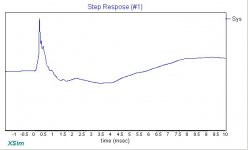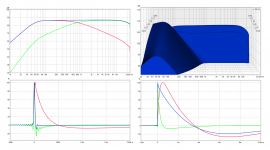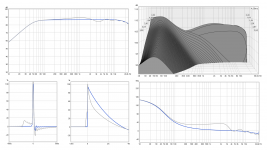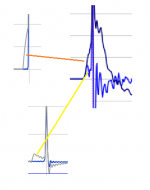Here is a passive FAST design using a small trapezoidal OB for the top and a sealed cabinet for the woofer. This speaker design was something I threw together in one night as a means to test out the FF85WK vs the eNabled variant from this thread. Here is a photo of the temporary speaker:
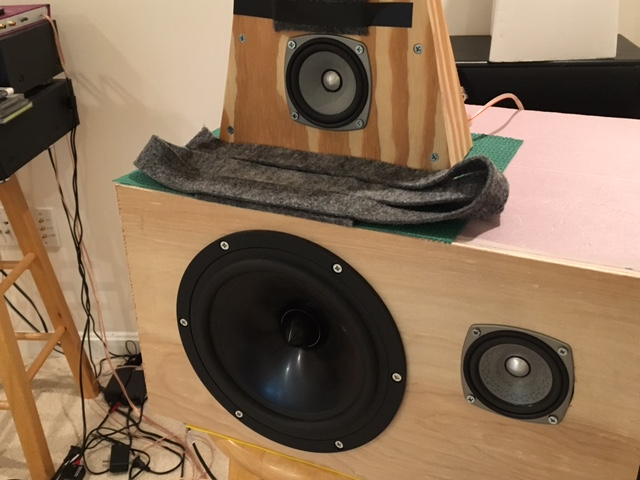
The OB is setback about 3.9in for time alignment and I placed some felt strips on the flat surface immediately in front to reduce reflections. The back of the OB has a wad of fiberlgass to smooth the back wave out.
I had a prexisting trapezoidal OB lying around from this thread, and the sealed woofer from this thread. So I installed a pristine FF85WK into the OB and proceeded to measured the response to produce minimum phase FRD files for the top/woofer/combo to use with Jeff Bagby's PCD package to design a passive XO. These drivers are pretty wide bandwidth (including the RS225) so that I went with a first order XO which also has other sonic benefits like great transients and superb imaging due to phase coherence. I then used DATS v2 to measure the electrical impedance of each driver in the speaker to produce the ZMA files needed for the XO sim.
After choosing a rather modest (low sensitivity) 75dB target SPL, I massaged the responses using a target textbook 1st order acoustic Butterworth HP/LP filters at 600Hz. It wasn't too hard to get these drivers to behave and I ended up with the following predicted response:
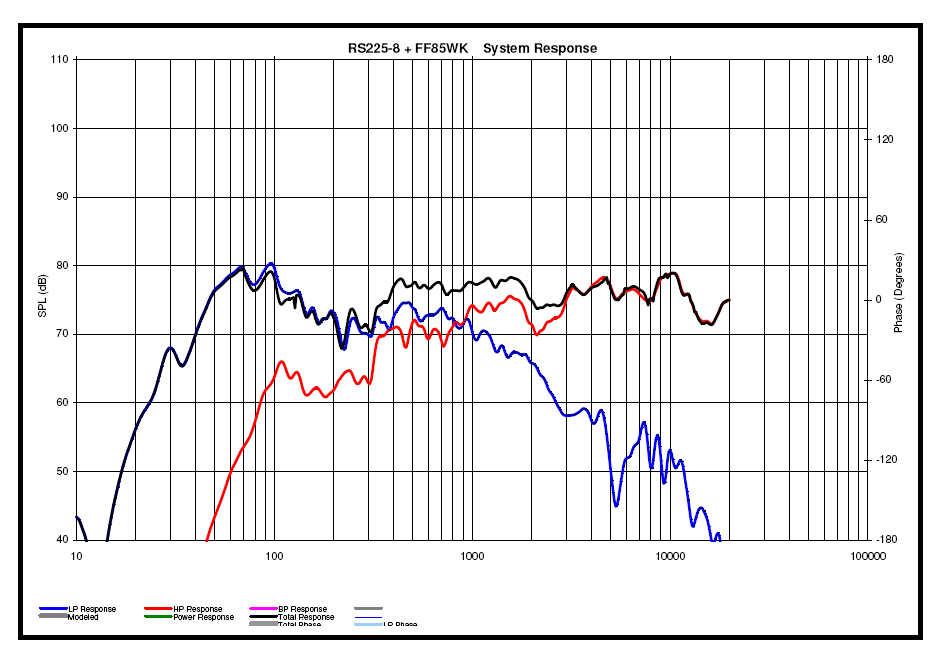
Here is the corresponding XO schematic (the R for the woofer inductor is the intrinsic value of the resistor). I actually used values for inductors that I had on hand so the DCR value is rather high given the thin gauge. However, I think there is a sonic benefit of higher DCR: the Qts goes up and bass extension is greatly improved. I did want to mention that this XO uses relatively low cost but high quality parts and can be made for quite little money. The 2.8mH inductor uses smaller 20ga wire and ferrite cores to achieve lower cost and built in higher DCR ($1.50), the 2.2uF caps are CBB 250v film caps ($0.33ea), resistors are 10w cement filled ($0.20ea), the big 51uF 450v cap is a motor run oil filled poly film unit for $11. Some folks may prefer to use air cores but I find that a woofer doesn't need that. Also - a 50uF audio grade film cap will cost a lot more. I find the sound of motor run caps is actually very good - especially when bypassed by a smaller 2.2uF film cap.
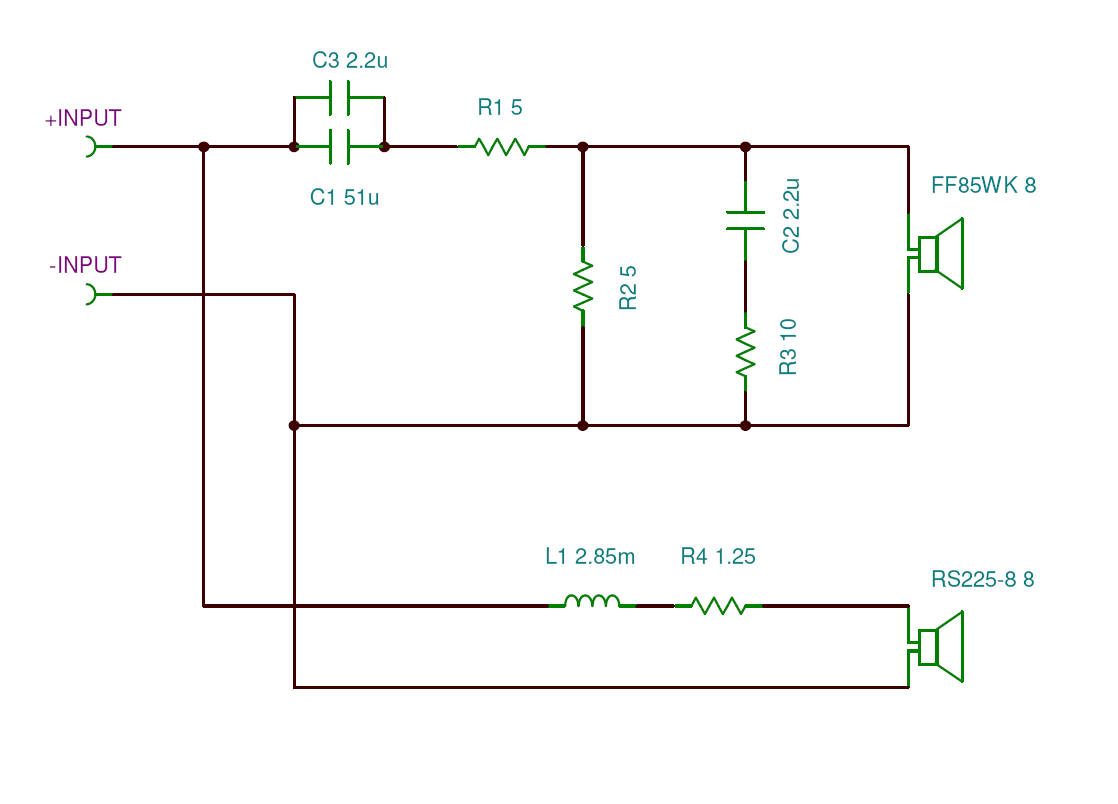
Here is the passive XO implementation:
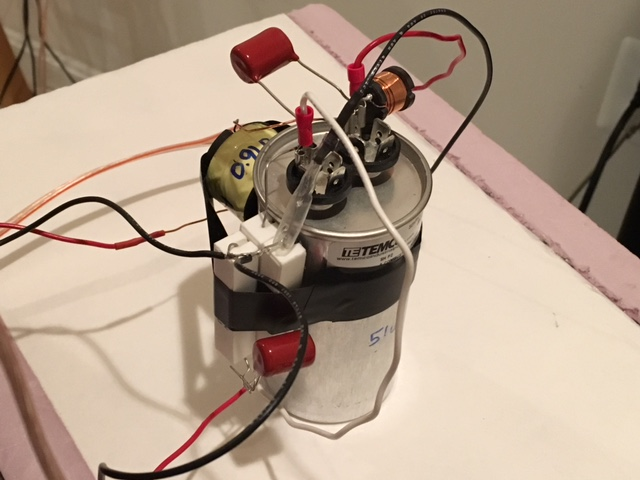
Update (6/9/2016): here is the XO used for the Blind ABX testing
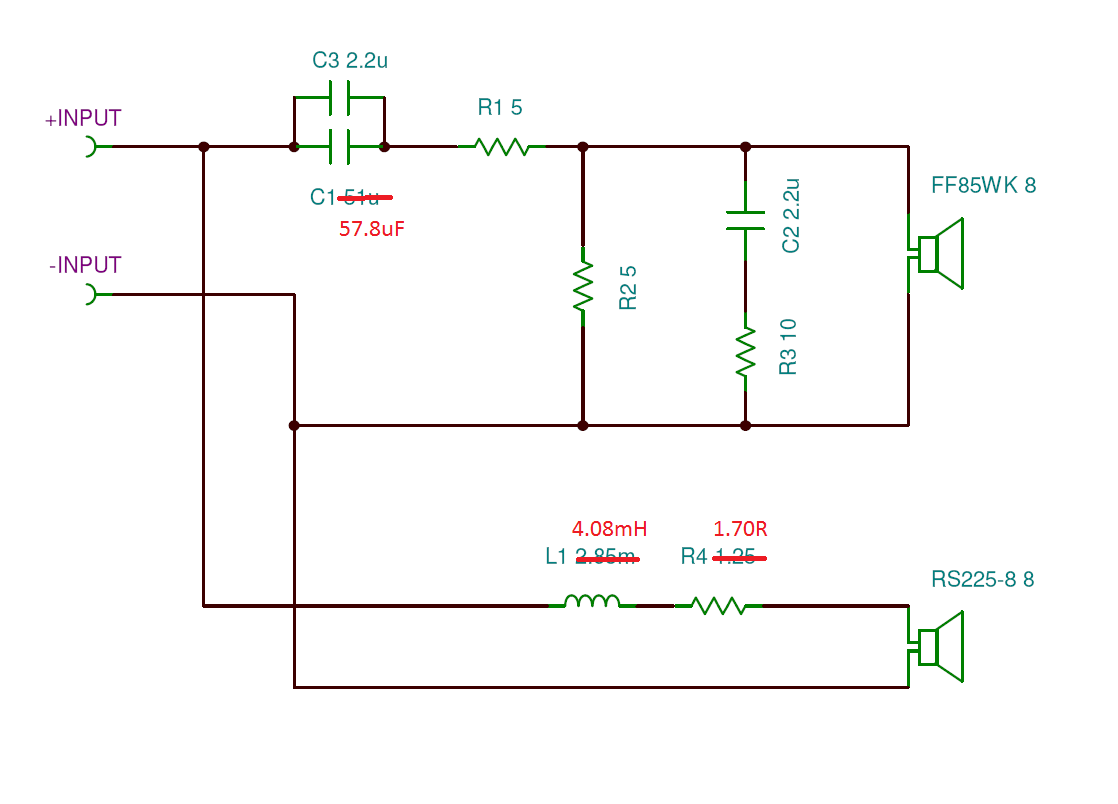
Here is the measured XO response plot at 0.5m:
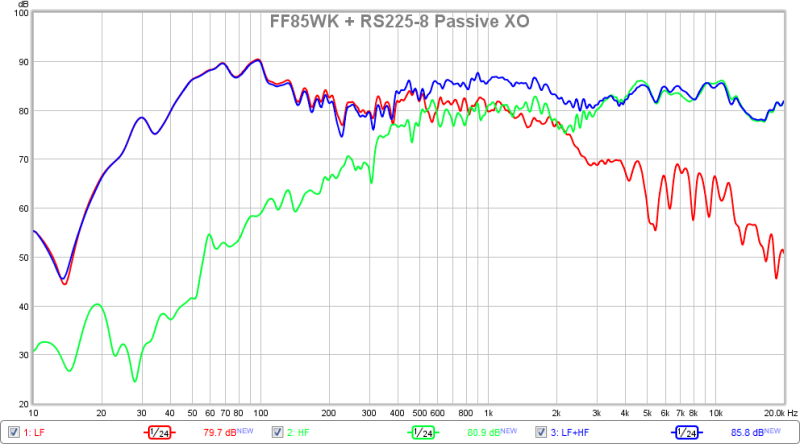
Here is the measured SPL and phase, showing a fairly linear region through the telephone band, F3 is around 40Hz, which is not bad given that it is a sealed system and there is no Linkwitz transform:
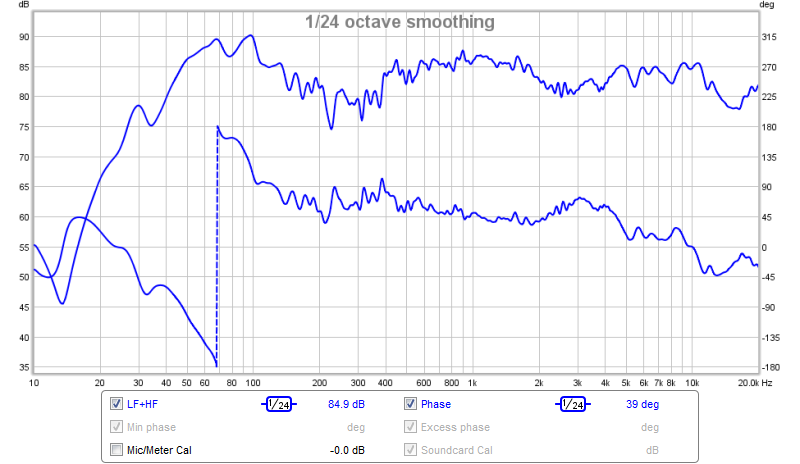
Here is the measured harmonic distortion, which is quite good:
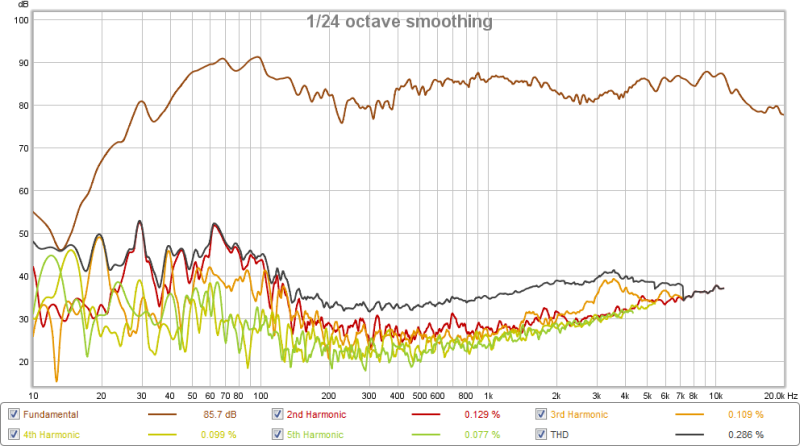
Here are the measured impulse and step responses - the triangle doesn't seem long enough, maybe someone can help me here:
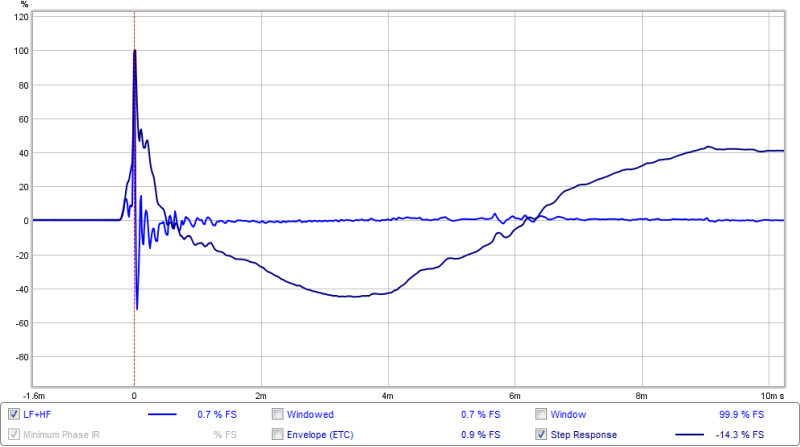
Listening to it, I have to say that coming from years of miniDSP and active bi/tri-amping it's kind of refreshing to have an all passive speaker that can be driven by my new class AB amps. I am using the vzaichenko/jwilhelm VHEX+ vertical MOSFET amp to drive this speaker for the test. The sound is very transparent, clear, and percussion instruments are tack sharp but not harsh/brittle. The FF85WK is proving itself to be a nice tweeter. Here is the amp used:
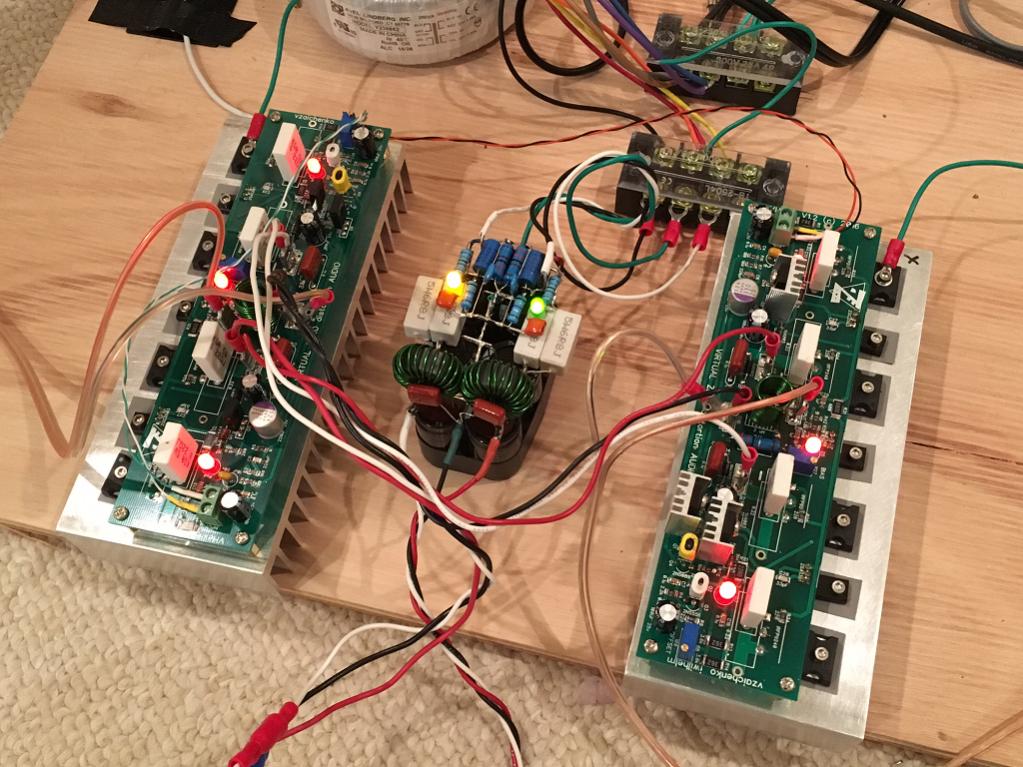
It's sounds so good in fact, I will probably build a dedicated cabinet and speaker. 🙂
Edit (June 4, 2016): I found out what was causing all the above strange behaviors. I got a new laptop and it has some hidden bass boost that could not be bypassed - until I used an external DAC. With that in place all is right now. The XO is a little different than shown above. I will post the new one soon.
FF85WK and RS225-8 Passive FAST
Take the xo response:
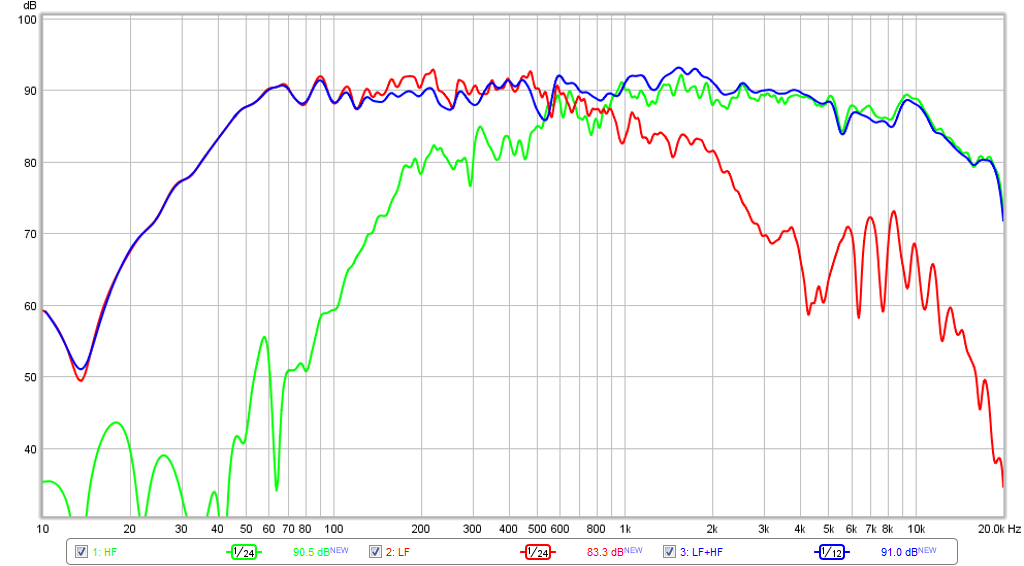
Measured phase:
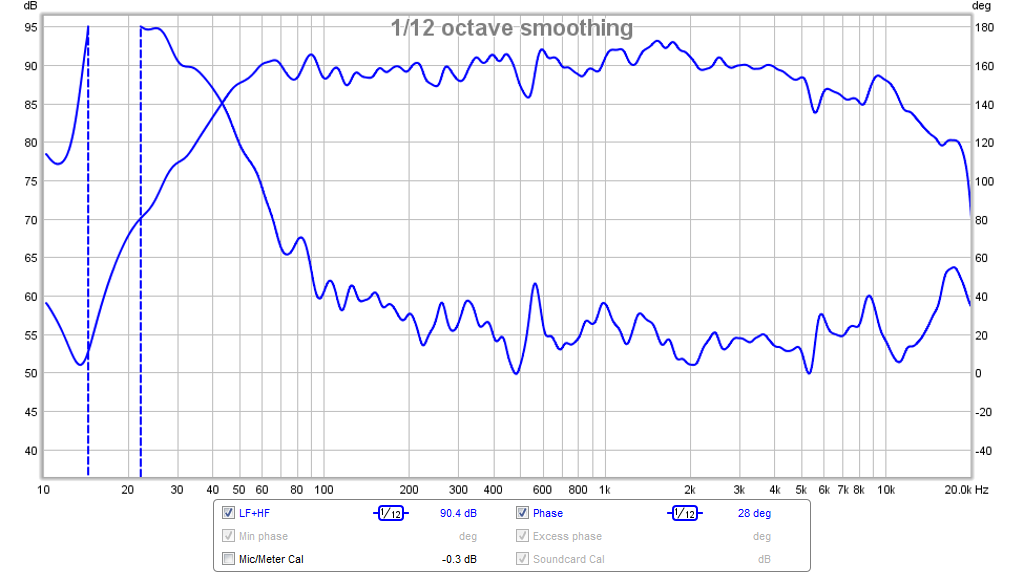
Measured distortion:
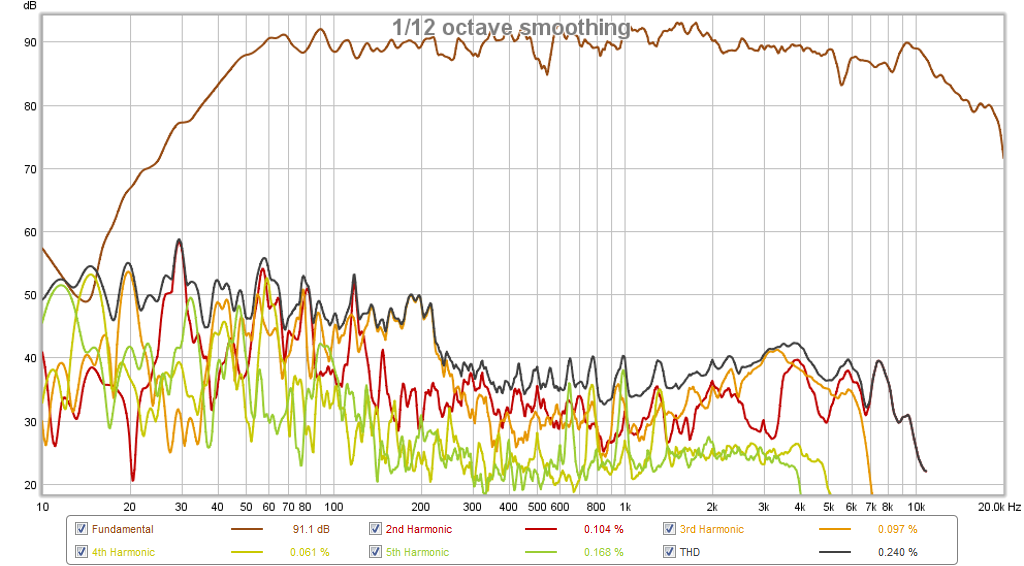
Impulse Response and Step Response:
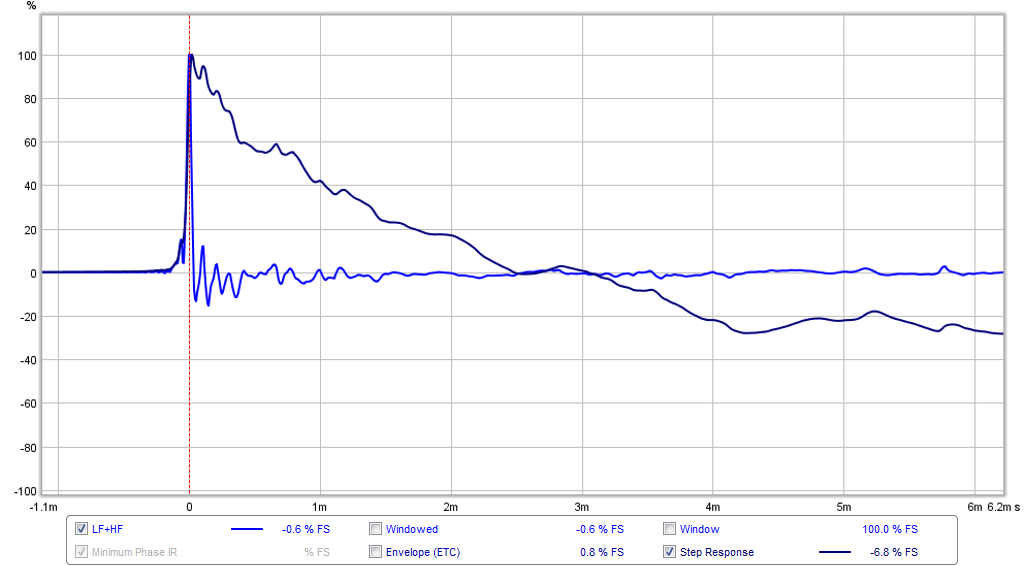
It can even play an ok square wave:
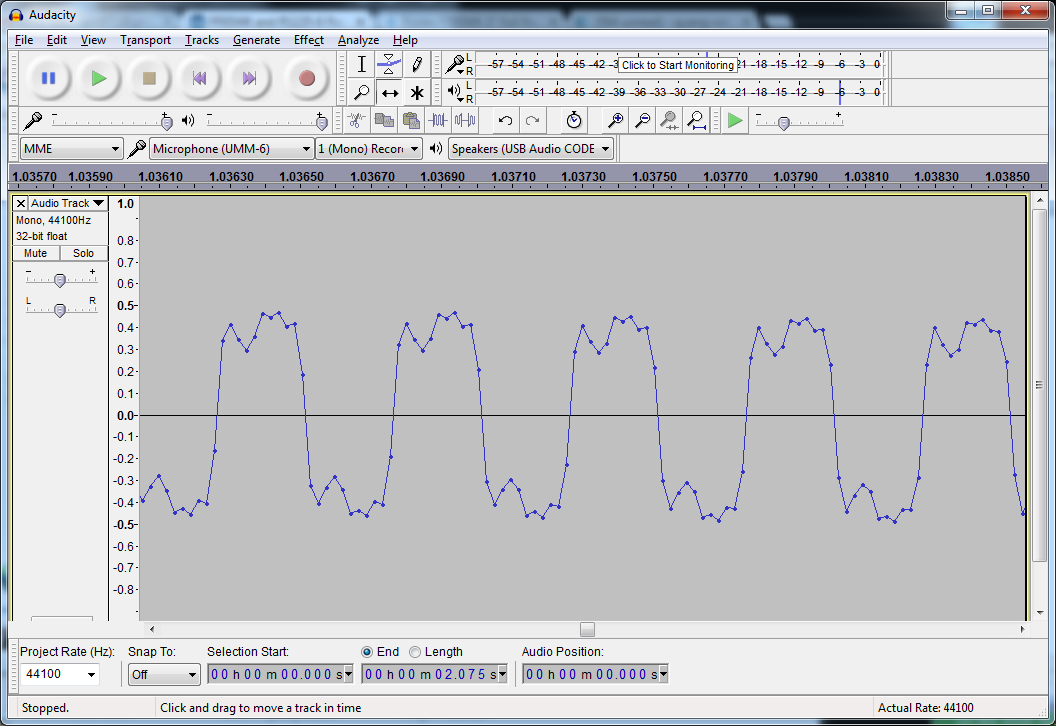
With a Cross Spectrum Labs UMIK-1 the response is a bit flatter:
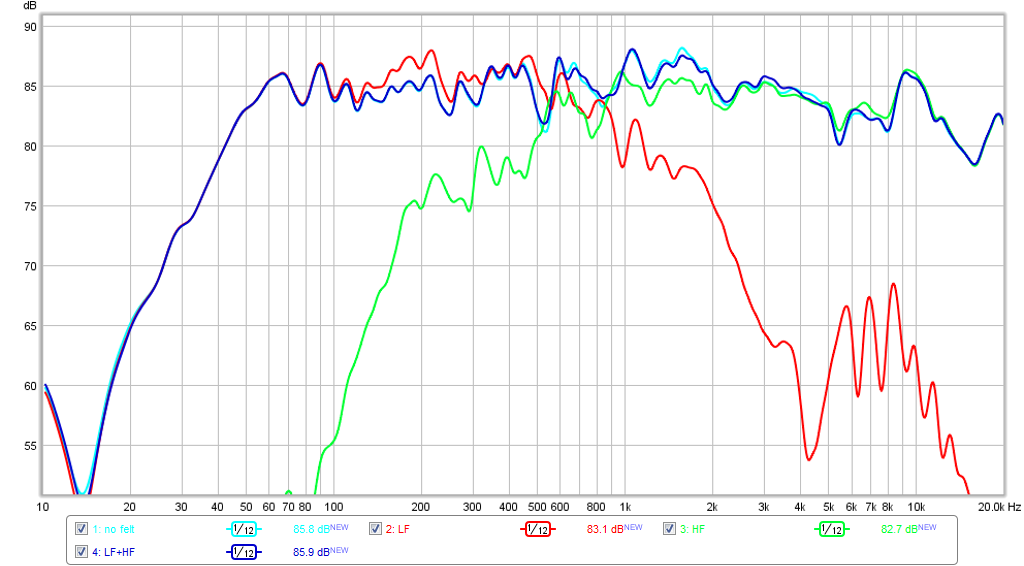
Phase with UMIK:
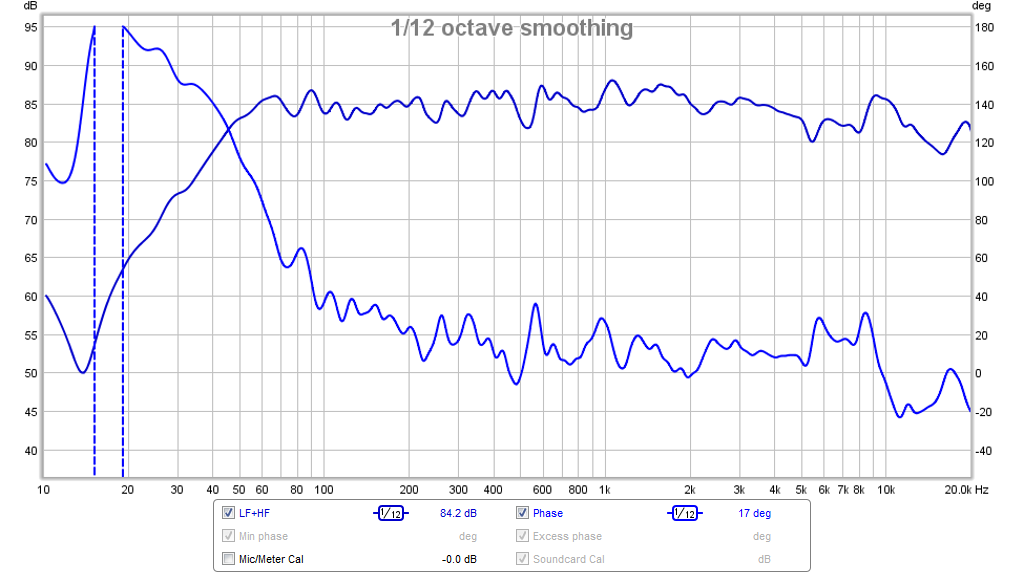
HD:
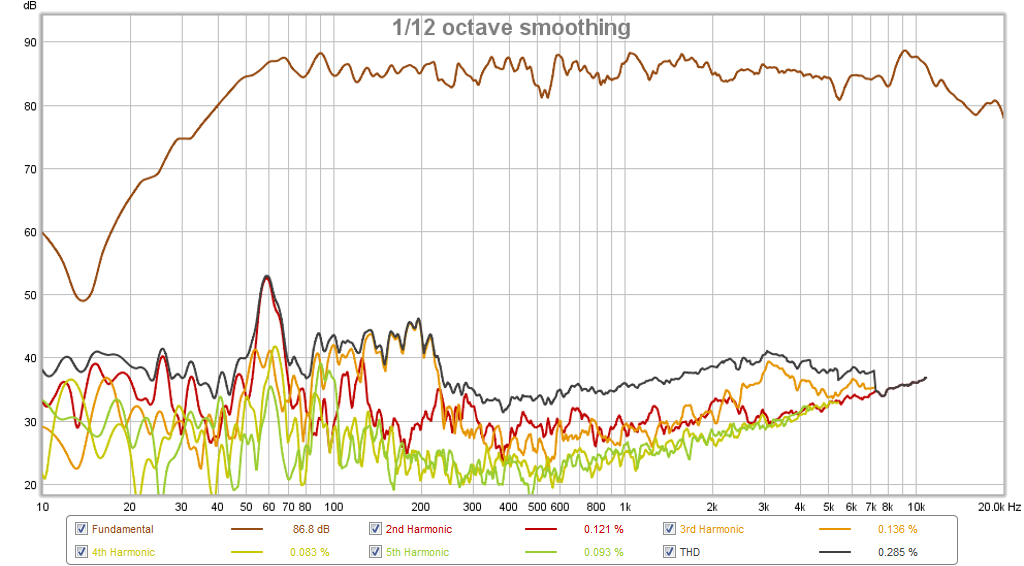
Step Response:
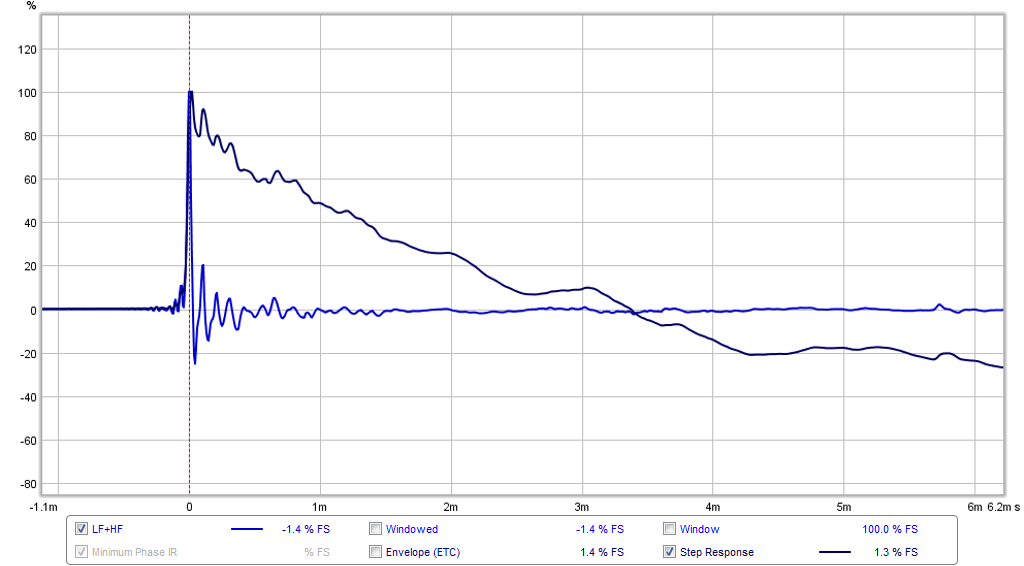

The OB is setback about 3.9in for time alignment and I placed some felt strips on the flat surface immediately in front to reduce reflections. The back of the OB has a wad of fiberlgass to smooth the back wave out.
I had a prexisting trapezoidal OB lying around from this thread, and the sealed woofer from this thread. So I installed a pristine FF85WK into the OB and proceeded to measured the response to produce minimum phase FRD files for the top/woofer/combo to use with Jeff Bagby's PCD package to design a passive XO. These drivers are pretty wide bandwidth (including the RS225) so that I went with a first order XO which also has other sonic benefits like great transients and superb imaging due to phase coherence. I then used DATS v2 to measure the electrical impedance of each driver in the speaker to produce the ZMA files needed for the XO sim.
After choosing a rather modest (low sensitivity) 75dB target SPL, I massaged the responses using a target textbook 1st order acoustic Butterworth HP/LP filters at 600Hz. It wasn't too hard to get these drivers to behave and I ended up with the following predicted response:

Here is the corresponding XO schematic (the R for the woofer inductor is the intrinsic value of the resistor). I actually used values for inductors that I had on hand so the DCR value is rather high given the thin gauge. However, I think there is a sonic benefit of higher DCR: the Qts goes up and bass extension is greatly improved. I did want to mention that this XO uses relatively low cost but high quality parts and can be made for quite little money. The 2.8mH inductor uses smaller 20ga wire and ferrite cores to achieve lower cost and built in higher DCR ($1.50), the 2.2uF caps are CBB 250v film caps ($0.33ea), resistors are 10w cement filled ($0.20ea), the big 51uF 450v cap is a motor run oil filled poly film unit for $11. Some folks may prefer to use air cores but I find that a woofer doesn't need that. Also - a 50uF audio grade film cap will cost a lot more. I find the sound of motor run caps is actually very good - especially when bypassed by a smaller 2.2uF film cap.

Here is the passive XO implementation:

Update (6/9/2016): here is the XO used for the Blind ABX testing

Here is the measured XO response plot at 0.5m:

Here is the measured SPL and phase, showing a fairly linear region through the telephone band, F3 is around 40Hz, which is not bad given that it is a sealed system and there is no Linkwitz transform:

Here is the measured harmonic distortion, which is quite good:

Here are the measured impulse and step responses - the triangle doesn't seem long enough, maybe someone can help me here:

Listening to it, I have to say that coming from years of miniDSP and active bi/tri-amping it's kind of refreshing to have an all passive speaker that can be driven by my new class AB amps. I am using the vzaichenko/jwilhelm VHEX+ vertical MOSFET amp to drive this speaker for the test. The sound is very transparent, clear, and percussion instruments are tack sharp but not harsh/brittle. The FF85WK is proving itself to be a nice tweeter. Here is the amp used:

It's sounds so good in fact, I will probably build a dedicated cabinet and speaker. 🙂
Edit (June 4, 2016): I found out what was causing all the above strange behaviors. I got a new laptop and it has some hidden bass boost that could not be bypassed - until I used an external DAC. With that in place all is right now. The XO is a little different than shown above. I will post the new one soon.
FF85WK and RS225-8 Passive FAST
Take the xo response:

Measured phase:

Measured distortion:

Impulse Response and Step Response:

It can even play an ok square wave:

With a Cross Spectrum Labs UMIK-1 the response is a bit flatter:

Phase with UMIK:

HD:

Step Response:

Attachments
-
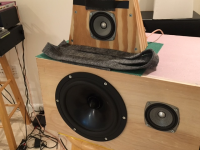 FF85WK-RS225-FAST-XO-Implementation-OB-Sealed.PNG500.6 KB · Views: 2,361
FF85WK-RS225-FAST-XO-Implementation-OB-Sealed.PNG500.6 KB · Views: 2,361 -
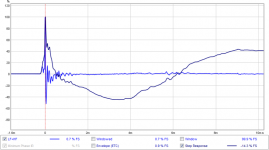 FF85WK-RS225-FAST-IR-SR.png43.4 KB · Views: 2,139
FF85WK-RS225-FAST-IR-SR.png43.4 KB · Views: 2,139 -
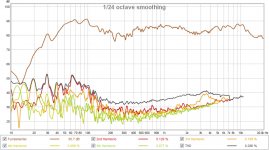 FF85WK-RS225-FAST-HD.png112.8 KB · Views: 2,301
FF85WK-RS225-FAST-HD.png112.8 KB · Views: 2,301 -
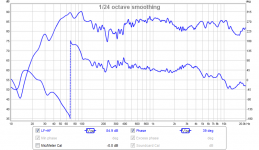 FF85WK-RS225-FAST-Phase.png56.6 KB · Views: 2,305
FF85WK-RS225-FAST-Phase.png56.6 KB · Views: 2,305 -
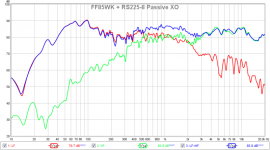 FF85WK-RS225-FAST-XO-Meas.png68.3 KB · Views: 2,361
FF85WK-RS225-FAST-XO-Meas.png68.3 KB · Views: 2,361 -
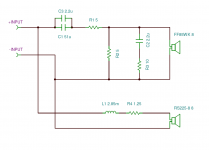 FF85WK-RS225-FAST-XO-Schematic.PNG36.1 KB · Views: 3,145
FF85WK-RS225-FAST-XO-Schematic.PNG36.1 KB · Views: 3,145 -
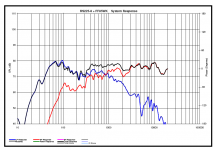 FF85WK-RS225-FAST-XO-predicted.PNG69.1 KB · Views: 2,418
FF85WK-RS225-FAST-XO-predicted.PNG69.1 KB · Views: 2,418 -
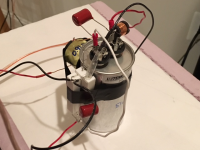 FF85WK-RS225-FAST-XO-Implementation.PNG439.8 KB · Views: 3,112
FF85WK-RS225-FAST-XO-Implementation.PNG439.8 KB · Views: 3,112
Last edited:
...I went with a first order XO which also has other sonic benefits like great transients and superb imaging due to phase coherence.
Here is the measured XO response plot at 0.5m:


Here are the measured impulse and step responses:

We see from the correlated summing and the resonating step response, that this is not a textbook first-order crossover. The tweeter is connected with reversed polarity, while it would be connected with not-reversed polarity in a linear-phase first-order crossover.
The rising edge of the tweeter goes up, and the positive driver terminal on the FF85WK is connected to the amp positive. So not sure why you think it's reversed.
If I take the predicted response from PCD (.FRD file) and import it into Xsim, the predicted step response matches what I measured - so I think it is just lack of bass extension is the reason why the SR right triangle is not bigger. The SR always oscillates afterwards.
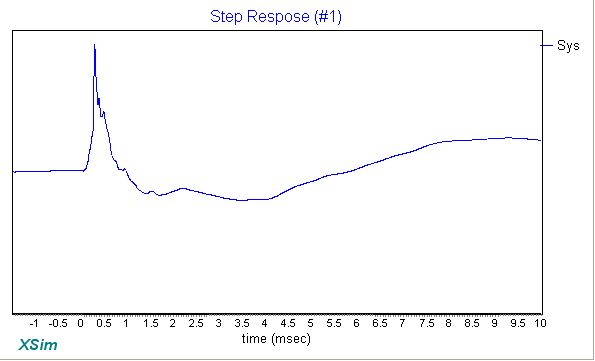
If I take the predicted response from PCD (.FRD file) and import it into Xsim, the predicted step response matches what I measured - so I think it is just lack of bass extension is the reason why the SR right triangle is not bigger. The SR always oscillates afterwards.

Attachments
Last edited:
.....I am using the vzaichenko/jwilhelm VHEX+ vertical MOSFET amp to drive this speaker for the test.....
🙂... nice amp
.....Here are the measured impulse and step responses - the triangle doesn't seem long enough, maybe someone can help me here.....
Modeled a woofer band pass where HP set BW2 52Hz and LP set BW1 800Hz cascaded a BW2 20kHz (red trace), and next (green trace) is set HP BW2 52Hz cascaded BW1 800Hz and LP 20kHz, system SR decay zero crossing with 52Hz f3 happen in plot at 3,4mS. Noticed in your SR plot it looks a bit like HARSCH XO where woofer is advanced in time, so did model with delayed mid-tweeter 200uS and it began look like the real world one, same signs for IR/SR and phase plot have bump around 3kHz. So if it happen be around a 200uS error the 3.9inch offset can be corrected to 1.2 inch offset.
Attachments
Thanks Byrtt! I am glad it is simple like time delay. I will give it a try.
Hope will work also because its simple and cheap just to move baffle but will it then still sound good : ) guess its because IR wasn't zero aligned and inside minimum phase domain data the two measurements imported to PCD then it couldn't predict better result. Simple calibration is just sweep and move until SR is as sharp a step as FF85WK would deliver alone without XO filter. But fear there is more work and capacitor or inductor can happen need new value if phase wasn't right presented into first PCD model.
Attachments
Moving it to 1.2in causes a sharp cancellation dip at 2k. Very strange, almost like its a LR2 or BW2 at 2kHz. I think the simplistic XO is not shaping the response close enough to the target. I might actually be better off trying to get a -24dB/oct BW low pass and -12dB/oct HPF and go for a Harsch XO.
Despite not having the transient perfect part sorted out yet - it sounds very good from a musical balance and voicing standpoint. I think this setup would actually be fine for use in testing of there are measurable or audible differences between pristine and enabled drivers.
Cool project. 😀
I've never gotten anything like a textbook 1st order low pass to work at around 600hz, that is to say give me a 1st order acoustic response. One thing that has worked on a couple occasions for me might be worth a try. Make basically a 3rd order lowpass, but put a damping resistor on the shunt leg. Let the computer run some iterations to get the acoustic rolloff right, or fiddle with it and measure.
The other passive solution that seems to work at relatively low crossover point is a series type crossover. Those are kind of weird: sometimes they are fantastic, other times far inferior to a parallel. Worth a try though. You have to watch for impedance dips.
I've never gotten anything like a textbook 1st order low pass to work at around 600hz, that is to say give me a 1st order acoustic response. One thing that has worked on a couple occasions for me might be worth a try. Make basically a 3rd order lowpass, but put a damping resistor on the shunt leg. Let the computer run some iterations to get the acoustic rolloff right, or fiddle with it and measure.
The other passive solution that seems to work at relatively low crossover point is a series type crossover. Those are kind of weird: sometimes they are fantastic, other times far inferior to a parallel. Worth a try though. You have to watch for impedance dips.
Thanks Gregb. 🙂
I have never made a series XO before and wouldn't know where to begin. I might give the passive Harsch a try. It may take more passive components than I have though. I think it's two inductors and two capacitors for a 4th order. The high pass will require an inductor for 2nd order. The setback will be kind of huge though for 600Hz Harsch at 11in back so may not be practical with such a low XO point. Will the 3rd order be able to give me a flat phase transient perfect though?
I have never made a series XO before and wouldn't know where to begin. I might give the passive Harsch a try. It may take more passive components than I have though. I think it's two inductors and two capacitors for a 4th order. The high pass will require an inductor for 2nd order. The setback will be kind of huge though for 600Hz Harsch at 11in back so may not be practical with such a low XO point. Will the 3rd order be able to give me a flat phase transient perfect though?
Do not kid me. What matters is the polarity relative between tweeter and woofer.The rising edge of the tweeter goes up, and the positive driver terminal on the FF85WK is connected to the amp positive.
Because the starting impulse, the one which goes up in thy step response plot, is too short, less than a millisecond. For comparison the step response of GA13:So not sure why you think it's reversed.

Two milliseconds, for GA13 has a lower limit frequency of 80Hz, and 1/(80*2*Pi)=0.002s.
Grasso,
Your attitude is smug and obnoxious and uncalled for. If you are not going to offer help or constructive comments just stop. This is not my first attempt at a transient perfect 1st order and I know what a good step response looks like.
Here was one my earlier ones with and AC130F1 and FR58EX.
http://www.diyaudio.com/forums/full-range/280331-fr58ex-ac130f1-micro-fast.html
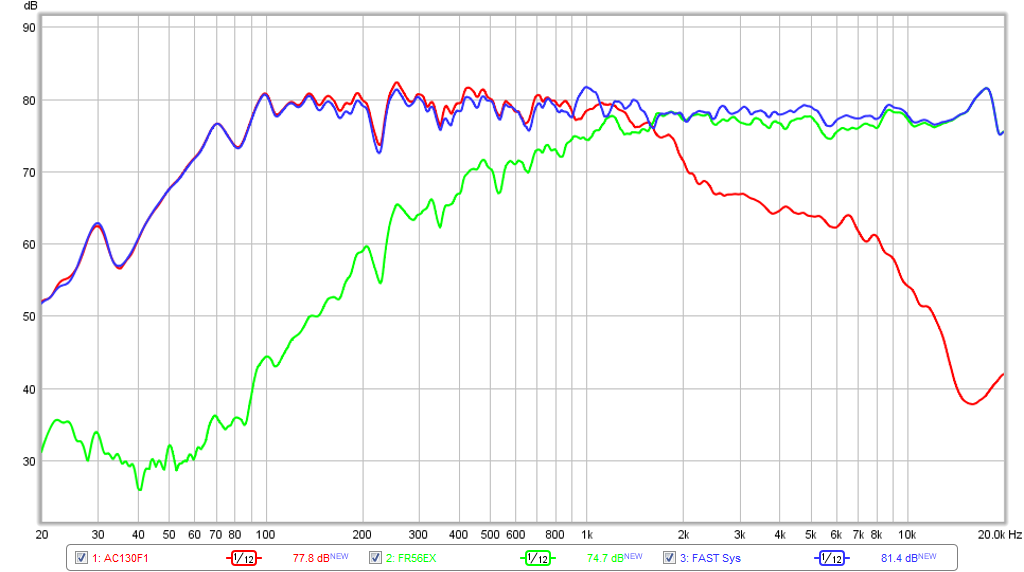
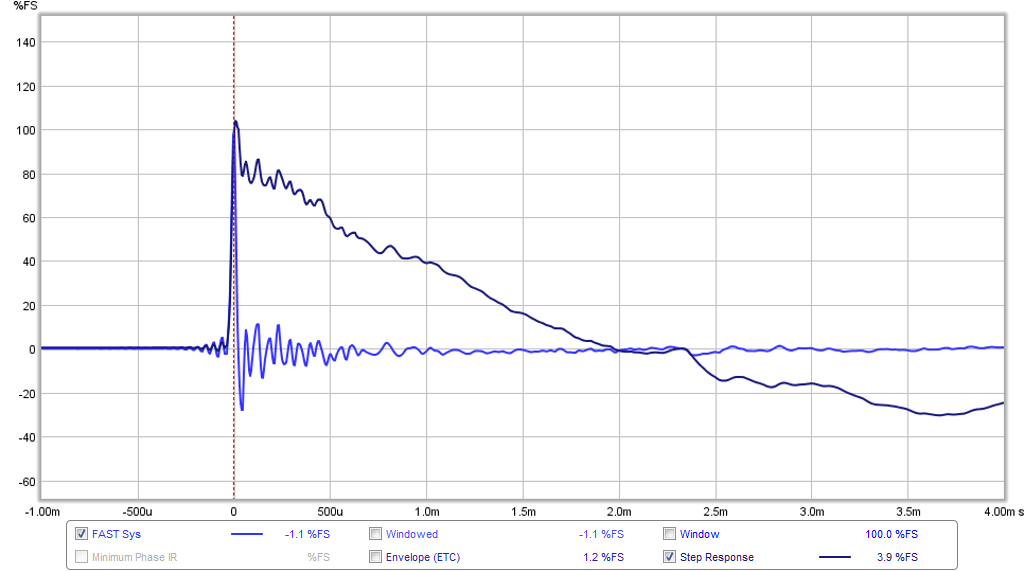
So I admit the results here are not ideal but the cause is certainly not because I have the polarity between tweeter and woofer flipped. I flipped it to check and the tweeter pulse goes down first.
Your attitude is smug and obnoxious and uncalled for. If you are not going to offer help or constructive comments just stop. This is not my first attempt at a transient perfect 1st order and I know what a good step response looks like.
Here was one my earlier ones with and AC130F1 and FR58EX.
http://www.diyaudio.com/forums/full-range/280331-fr58ex-ac130f1-micro-fast.html


So I admit the results here are not ideal but the cause is certainly not because I have the polarity between tweeter and woofer flipped. I flipped it to check and the tweeter pulse goes down first.
Will the 3rd order be able to give me a flat phase transient perfect though?
It will if you tweak it so that the acoustic low pass is 1st order. 🙂
It's not really 3rd order. Think of it as a choke, a zobel, and then another choke. Because the shunt leg is damped, it won't really give you anywhere near 3rd acoustic roll off. It's not the only topology that will do this of course.
Harsch might be good. One of these days I'll try it.
RE series crossovers - there used to be more info on the web about them but not much these days. At the most basic level, you'd take textbook values for a Butterworth 1st passive crossover, but instead of connecting them the standard way, you shunt the 'high pass' cap across the woofer, and shunt the choke across the HF driver. Of course there is more to it than that.
I think the fact that it sounds good even with a not quite optimum starting point is a very good sign.
Well, for someone interesting in dipping their toe in the Series XO design pool, I think there are a couple of spreadsheets, such as
Series Crossover Designer
Series Crossover Designer
X!
Your crossover is fine, in fact the step response is top-noth compared to most of the commercial loudspeakers out there. Just have a look at Stereophiles measurements of mega expensive boxes that in most cases look like compared to this.
compared to this.
Ok?

Your crossover is fine, in fact the step response is top-noth compared to most of the commercial loudspeakers out there. Just have a look at Stereophiles measurements of mega expensive boxes that in most cases look like
 compared to this.
compared to this.Ok?

Obnoxious means bothering, but what does smug mean? If it has something to do with smuggle, then the blame is rather on thee.Your attitude is smug and obnoxious and uncalled for.
Of course it will go down, if it went up before, and thou have flipped polarity inbetween. Please double-check thy stuff and write it out, so thou may see the mistake thou made. Self-doubt helps sometimes.So I admit the results here are not ideal but the cause is certainly not because I have the polarity between tweeter and woofer flipped. I flipped it to check and the tweeter pulse goes down first.
Obnoxious means bothering, but what does smug mean?
Smug - definition of smug by The Free Dictionary
I'd imagine that xrk would have been referring to the 1st definition usually found
Grasso,
It must be a language thing because the last time I saw thy and thou used was the bible. I think you mean well but are using some crazy German to English translator program with the settings set to "King James the omniscient" mode.
Regards,
X
It must be a language thing because the last time I saw thy and thou used was the bible. I think you mean well but are using some crazy German to English translator program with the settings set to "King James the omniscient" mode.
Regards,
X
Grasso,
It must be a language thing because the last time I saw thy and thou used was the bible. I think you mean well but are using some crazy German to English translator program with the settings set to "King James the omniscient" mode.
Regards,
X

Thank thee, Chris, smug is related to German schmücken to decorate. I see a serious mistake in this X's presentation of and in his new loudspeaker, i keep nothing to myself.
X, the modern polite grammatic form you is a nightmare. Sticking to it, one cannot distinguish singular and plural anymore. I rather adress thee, X, and all of you, folks explicitely.
ewollowe, going back further in time, the English th is a case of misunderstanding, too. In Greek, H is eta, pronounced as long e, so TH is pronounced as tee. A monastery freak a thousand years ago wrote out all tees as th, and a laymen preacher invented a new sound for these occurances of th.
X, please state it clearly, which polarity do woofer and tweeter have relative to each other, same or reversed? Thou can also draw + and - signs in the crossover chart.
X, the modern polite grammatic form you is a nightmare. Sticking to it, one cannot distinguish singular and plural anymore. I rather adress thee, X, and all of you, folks explicitely.
ewollowe, going back further in time, the English th is a case of misunderstanding, too. In Greek, H is eta, pronounced as long e, so TH is pronounced as tee. A monastery freak a thousand years ago wrote out all tees as th, and a laymen preacher invented a new sound for these occurances of th.
X, please state it clearly, which polarity do woofer and tweeter have relative to each other, same or reversed? Thou can also draw + and - signs in the crossover chart.
- Status
- Not open for further replies.
- Home
- Loudspeakers
- Full Range
- FF85WK and RS225-8 Passive WAW / FAST
